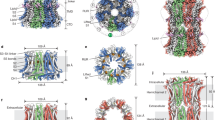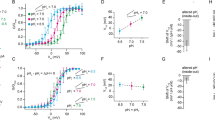Abstract
Ca2+- and voltage-activated K+ channels are found in many electrically excitable cells and have an important role in regulating electrical activity1–4. Recently, the large K+ channel has been found in the baso-lateral plasma membranes of salivary gland acinar cells, where it may be important in the regulation of salt transport5. Using patch-clamp methods6,7 to record single-channel currents from excised fragments of baso-lateral acinar cell membranes in combination with current recordings from isolated single acinar cells and two- and three-cell clusters, we have now for the first time characterized the K+ channels quantitatively. In pig pancreatic acini there are 25–60 K+ channels per cell with a maximal single channel conductance of about 200 pS. We have quantified the relationship between internal ionized Ca2+ concentration ([Ca2+]i) membrane potential and open-state probability (p) of the K+ channel. By comparing curves obtained from excised patches relating membrane potential to p, at different levels of [Ca2+]i, with similar curves obtained from intact cells, [Ca2+]i in resting acinar cells was found to be between 10−8 and 10−7 M. In microelectrode experiments acetylcholine (ACh), gastrin–cholecystokinin (CCK) as well as bombesin peptides evoked Ca2+-dependent opening of the K+ conductance pathway, resulting in membrane hyperpolarization. The large K+ channel, which is under strict dual control by internal Ca2+ and voltage, may provide a crucial link between hormone-evoked increase in internal Ca2+ concentration and the resulting NaCl-rich fluid secretion5,8.
This is a preview of subscription content, access via your institution
Access options
Subscribe to this journal
Receive 51 print issues and online access
$199.00 per year
only $3.90 per issue
Buy this article
- Purchase on Springer Link
- Instant access to full article PDF
Prices may be subject to local taxes which are calculated during checkout
Similar content being viewed by others
References
Marty, A. Nature 291, 497–500 (1981).
Pallotta, B. S., Magleby, K. L. & Barrett, J. N. Nature 293, 471–774 (1981).
Latorre, R. & Miller, C. J. Membrane Biol. 71, 11–30 (1983).
Meech, R. W. A. Rev. Biophys. Bioengng 7, 1–18 (1978).
Maruyama, Y., Gallacher, D. V. & Petersen, O. H. Nature 302, 827–829 (1983).
Hamill, O. P., Marty, A., Neher, E., Sakmann, B. & Sigworth, F. J. Pflügers Arch. ges. Physiol. 391, 85–100 (1981).
Neher, E. in Techniques in Cellular Physiology Vol. 1, Pt II (ed. Baker, P. F.) P 121, 1–16 (Elsevier, Amsterdam, 1982).
Lindkaer-Jensen, S. et al. Acta physiol. scand. 111, 225–231 (1981).
Petersen, O. H. The Electrophysiology of Gland Cells (Academic, London, 1980).
Ginsborg, B. L., House, C. R. & Silinsky, E. M. J. Physiol., Lond. 236, 723–731 (1974).
Maruyama, Y. & Petersen, O. H. Nature 300, 61–63 (1982).
O'Doherty, J. & Stark, R. J. Am. J. Physiol. 242, G513–521 (1982).
Author information
Authors and Affiliations
Rights and permissions
About this article
Cite this article
Maruyama, Y., Petersen, O., Flanagan, P. et al. Quantification of Ca2+-activated K+ channels under hormonal control in pig pancreas acinar cells. Nature 305, 228–232 (1983). https://doi.org/10.1038/305228a0
Received:
Accepted:
Issue Date:
DOI: https://doi.org/10.1038/305228a0
This article is cited by
-
Potassium channels in pancreatic duct epithelial cells: their role, function and pathophysiological relevance
Pflügers Archiv - European Journal of Physiology (2015)
-
Localization of Ca2+-activated big-conductance K+ channels in rabbit distal colon
Pflügers Archiv - European Journal of Physiology (2003)
-
Changes in element concentrations induced by agonist in pig pancreatic acinar cells
Pflügers Archiv - European Journal of Physiology (1996)
-
Ca2+-activated K+-channels in the nuclear envelope isolated from single pancreatic acinar cells
Pfl�gers Archiv European Journal of Physiology (1995)
-
A voltage-sensitive transient potassium current in mouse pancreatic acinar cells
Pfl�gers Archiv European Journal of Physiology (1994)
Comments
By submitting a comment you agree to abide by our Terms and Community Guidelines. If you find something abusive or that does not comply with our terms or guidelines please flag it as inappropriate.



